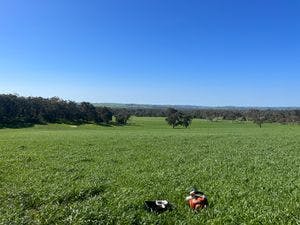
Predicting redlegged earth mite hatch dates
30 October 2023

Josh Thia

James Maino
The hatching of redlegged earth mite (RLEM) eggs in autumn is dependent on specific climatic conditions. Accurate knowledge of the hatch time is crucial for effectively managing high-risk paddocks. To aid in this management, the hatch timing tool utilises local climatic data to predict the precise dates of egg hatching. Certain regions in NSW, VIC, and Tasmania have already experienced the necessary conditions for hatching this year.
Knowing hatch date improves management
Redlegged earth mite (Halotydeus destructor) can cause significant damage to crops, especially during seedling establishment. This species has a complicated lifecycle with different timing for egg laying and hatching through out the year, and has shown the ability to evolve insecticide resistance, so it can be a difficult one to manage.
Redlegged earth mites can have up to 4 generations per season. In autumn, over-summering eggs hatch when there is significant rainfall and the mean daily temperatures fall below approximately 19°C. The first few generations lay eggs that mostly hatch during winter. It takes approximately 4-6 weeks for nymphs to develop into mature adults. In spring, adult mites produce over-summering diapause eggs that are retained in their bodies.
In paddocks where risk is high or with a history of heavy redlegged earth mite pest loads, spraying might be required, and timing is key. To know if your paddocks are at risk of Redlegged earth mite, use the interactive risk calculator.
The optimal spray timing is directly after hatching of the over-summering eggs (in April-May) to protect emerging crop plants. Autumn monitoring is also important as large numbers can overwhelm the protection offered by seed treatments. So, knowing when eggs are likely to hatch is critical for management of this pest over the winter cropping season.
Predictions from the hatch timing tool
The hatch timing tool helps to aid decision making by predicting when eggs will hatch in autumn, which indicates when to increase crop monitoring. Cesar Australia developed this tool to estimate the timing of egg hatch in different locations using climate data from the current year and historical data from the past years 25 years.
The picture below shows the current predicted hatch dates for different regions in Australia. Each colour represents the month in which hatch is predicted to occur.

Note that the image above is just the average expectation. Because there is no such thing as an “average year”, below shows the hatching prediction based on climatic data for the current year.
Use the online hatch tool to get more precise predictions for your region in the current season.

As you can see on the second map, there are some areas in NSW, VIC, and Tasmania which have already experienced conditions suitable for RLEM hatching and should be prioritised for monitoring accordingly.
More information on Redlegged earth mite monitoring and management
Ground truthing predictions
To improve the usefulness of our hatch timing tool, we require additional validation of the estimates provided by the model. Reports from growers and advisors are an extremely valuable part of this validation. If you have used the tool and checked to see whether mites were present, please consider providing your report via this form. It only takes a minute!
If you have any other feedback about future features, we would love to hear from you. Please let us know, by sending an email to: pestfacts@cesaraustralia.com
Acknowledgements
This web tool was developed by Dr James Maino through a GRDC investment (CES2010-001RXT) with contributions from CSIRO, Cesar Australia, the University of Melbourne, and the Department of Primary Industries and Regional Development.
